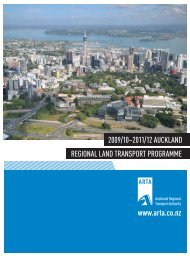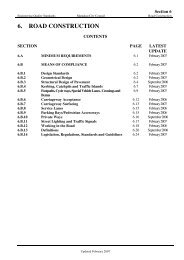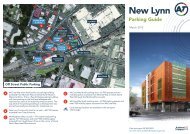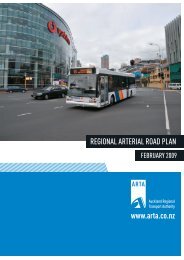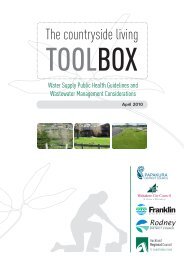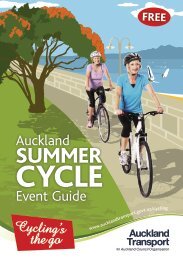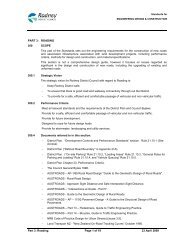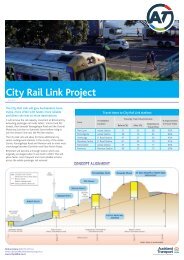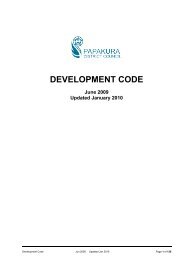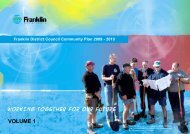Travelwise Week Unit Plan - Auckland Transport
Travelwise Week Unit Plan - Auckland Transport
Travelwise Week Unit Plan - Auckland Transport
Create successful ePaper yourself
Turn your PDF publications into a flip-book with our unique Google optimized e-Paper software.
showing a developing understanding of<br />
their effects. (Level 3)<br />
• Use a range of language features<br />
appropriately, showing an increasing<br />
understanding of their effects. (Level 4)<br />
Structure<br />
• Organise texts using simple structures.<br />
(Level 1)<br />
• Organise texts, using a range of structures.<br />
(Level 2)<br />
• Organise texts, using a range of<br />
appropriate structures. (Level 3)<br />
• Organise texts using a range of<br />
appropriate structures.(Level 4)<br />
Processes and strategies<br />
• Integrate sources of information,<br />
processes, and strategies with developing<br />
confidence to identify, form and express<br />
ideas. (Level 3)<br />
• Integrate sources of information,<br />
processes, and strategies confidently to<br />
identify, form and express ideas. (Level 4)<br />
English – Listening, Reading &<br />
Viewing<br />
Purposes and audience<br />
• Recognise that texts are shaped for<br />
different purposes and audiences. (Level 1)<br />
• Show some understanding of how texts<br />
are shaped for different purposes and<br />
audiences. (Level2)<br />
• Show a developing understanding of how<br />
texts are shaped for different audiences<br />
and purposes. (Level 3)<br />
• Show an increasing understanding of how<br />
texts are shaped for different purposes<br />
and audiences. (Level 4)<br />
• a clear <strong>Travelwise</strong> message<br />
• clear font, format and colour<br />
• event details (where, when, what etc.)<br />
• Create a brochure that has the following elements:<br />
• a description of each type of transport<br />
• an illustration that supports text<br />
• Read a news article and identify the who, what, when, where,<br />
why/how<br />
• Read non-fiction books on the topic of transport<br />
• Write a poem with a <strong>Travelwise</strong> theme<br />
Insert the name of the poem model e.g. Acrostic<br />
WALT: (Level 3)<br />
• Write a detailed set of directions that someone else can<br />
follow<br />
• Plot our route on a map and add a scale and key<br />
• Write a detailed set of instructions for someone who has<br />
never used public transport.<br />
(Insert the mode of transport chosen e.g. bus)<br />
• Write a letter to the Principal using persuasive language to<br />
outline an issue of concern and a potential solution<br />
• Create a postcard that has the following elements:<br />
• address<br />
• brief message<br />
• illustration<br />
• descriptive language (to describe physical features; land<br />
marks, road safety etc…)<br />
• Use different mediums to recount our travel experiences<br />
during <strong>Travelwise</strong> <strong>Week</strong><br />
• Explain in writing how something works or happens and<br />
provide labels and a diagram to support it<br />
• Design an advertisement that has the following features:<br />
• a clear <strong>Travelwise</strong> message<br />
• persuasive language (emotive words)<br />
• clear font, format and colour<br />
• event details (where, when, what etc.)<br />
• Create a brochure that has the following elements:<br />
• a description of each type of transport used<br />
3. Instructions (Level 2,3,4)<br />
Students can write a set of instructions for how to catch a bus,<br />
train or ferry. Students can use their school as a starting point .<br />
They may want to consider including the following elements:<br />
• location of bus station/stop, train station or ferry terminal<br />
• time table<br />
• cost (ticket)<br />
• duration of trip<br />
• potential hazards to avoid<br />
4.Rules/Guidelines (Level 1,2,3,4)<br />
Get students to brainstorm and record a set of rules/guidelines<br />
for one of the following topics:<br />
• Riding on a bus/train<br />
• Walking to school<br />
• Riding a bike/skateboard/scooter to school<br />
(Refer to the Ministry of Education: School <strong>Transport</strong> Fact Sheets 7,8,9<br />
for information on buses).<br />
Extension: Create a class or school Road Safety Policy.<br />
4. Letter to the Principal (Level 3,4)<br />
Whole class - shared writing, group, individual<br />
Class to brainstorm road safety issues and traffic problems<br />
that may affect their school (e.g. cars speeding, air pollution,<br />
people parking on yellow lines).<br />
Get students to identify possible actions the school could<br />
take to solve some of these issues. Students can write a letter<br />
to the principal stating what their issue is, providing some<br />
background information and putting forward their ideas to<br />
resolve it.<br />
Extension: Write a Letter to the Editor of a local newspaper.<br />
5. Postcard (Level 2,3)<br />
This is a creative activity.<br />
Ask the students to choose another area in their region, do<br />
some research on the place and work out how they could<br />
travel there sustainably.<br />
<strong>Travelwise</strong> <strong>Week</strong> <strong>Unit</strong> <strong>Plan</strong>



